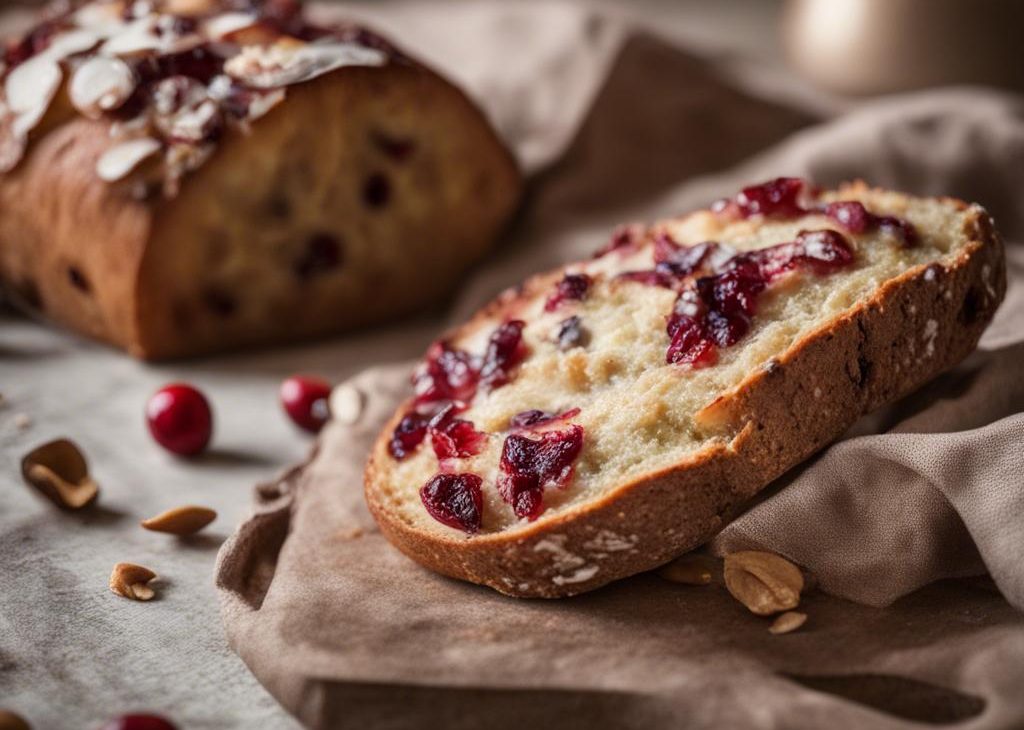


Yeasted bread has never been easier. This simple method produces the most beautiful and crusty cranberry nut no-knead bread with very little hands-on work! If you’re new to working with yeast, reference my Baking with Yeast Guide for answers to common yeast FAQs.
“Homemade bread” and “easy” are terms that don’t typically go hand-in-hand. When you think of homemade bread, you think difficult, right? This recipe, however, will completely change that thought. I realize that’s a pretty big promise, but I’m confident your perception of homemade bread will switch from “nope! too much work” to “wow, I CAN do this.”
This bread, like my homemade artisan bread, seeded oat bread, asiago-crusted skillet bread, and olive bread, has all the bells and whistles of a fresh-from-the-bakery cranberry nut bread, and takes very little effort. If you are new to working with yeast, or simply feeling a little lazy, this recipe is for you.
Making this loaf will leave you plenty of time to loaf around. 😉
You don’t need a lot of ingredients to make homemade bread, and you might already know that if you’ve tried this sandwich bread recipe. You only need 7 ingredients to make this bread:
By the way, if you enjoy honey in your homemade bread, you’ll love this no-knead honey oat bread because the flavor really stands out. The process is also very similar to today’s easy bread recipe. And both breads are delicious warm or toasted and topped with this easy homemade honey butter.
This no-work, no-knead, professional-bread-at-home concept originated with Jim Lahey of Sullivan Street Bakery in NYC. It’s all very basic ingredients, but his method is unique, which includes an 18-hour rise time. 18 hours?! Yes! Don’t be nervous, this 18 hours gives the dough a chance to ferment. And the fermentation time requires absolutely nothing from you. Just set it on your counter and forget about it until the next day. We use this same method for homemade English muffins. In both recipes, the magic happens when you’re not looking!
Step 1: Stir ingredients together. Don’t even break out your mixer.
This will be a super sticky dough. Remember, do NOT be tempted to add more flour. It will stick to your hands. That’s nothing a quick wash can’t fix!
Step 2: Cover the dough and ignore it.
Let the dough rise at room temperature for 12–18 hours. This recipe is very forgiving. Any normal-ish room temperature is fine. You’ll know that the dough is finished rising when it has about doubled in size and air bubbles have formed on top. Like this:
Step 3: The dough will still be super sticky after rising. That’s ok! Using lightly floured hands, form the sticky dough into a ball and place on a large piece of parchment paper. Score the top with a sharp knife, kitchen shears, or bread lame, then allow to rest for 30 minutes.
Step 4: Preheat a 5- to 6-quart Dutch oven. You’ll bake the bread in a pre-heated (super-hot!) Dutch oven, which helps form a crusty exterior. If you don’t have a Dutch oven, you can use any oven-safe heavy-duty pot with a lid.
Step 5: Bake for about 35 minutes. For an accurate doneness test, the bread is done when an instant-read thermometer reads the center of the loaf as 195°F (90°C).
Baking the bread with the lid on traps steam inside the pot, creating that perfectly crisp crust. A lid is the secret to this bread recipe’s success! You won’t regret picking up a Dutch oven.
No Dutch oven? No problem.
While baking the bread in a Dutch oven is key to this bread’s texture, you can get around it. Instead, place the rounded dough on a parchment paper-lined or generously floured nonstick baking pan. No need to pre-heat the pan like you do the Dutch oven. While the oven preheats and the scored loaf is resting, boil a kettle of water. After the oven is preheated, place scored dough/baking pan on the center rack. Then place a shallow metal baking/roasting pan or cast-iron skillet (I usually use a metal 9×13-inch baking pan; do not use glass) on the bottom oven rack. Carefully and quickly pour 3–4 cups of boiling water into it, and then quickly shut the oven door to trap the steam inside. The steam helps create a crispier crust. This is exactly how I bake 4-ingredient artisan bread.
Step 6: Enjoy a slice of warm, fresh bread you won’t believe you made from scratch.
This lightly honey-sweetened cranberry nut bread is fabulous for breakfast, toasted with butter or honey butter. Or serve it alongside a charcuterie board with a soft cheese like brie or goat cheese, or this white cheddar cranberry pecan cheese ball (yum!).
This recipe is brought to you in partnership with Red Star Yeast.
Yeasted bread has never been easier. This simple mixing method produces the most beautiful and crusty cranberry nut no-knead bread with very little hands-on work! If you’re new to working with yeast, reference my Baking with Yeast Guide for answers to common yeast FAQs.